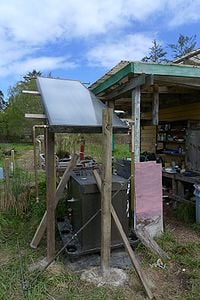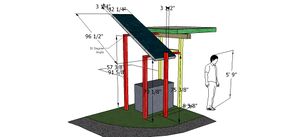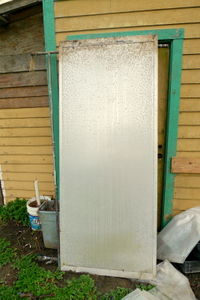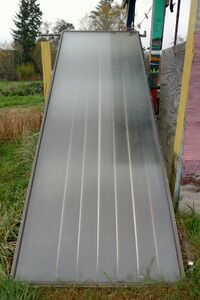Background

The Arcata Educational Farm is a CSA (Community-Supported Agriculture establishment) that provides local organic produce for members/shareholders and hands-on agricultural education for local students and residents. Adjacent and connected to the farm is the upcoming Bayside Community Garden, a place for residents to grow their own produce and learn how to farm organically and sustainably.
As part of our ENGR305 class, our team was asked to fix the solar water heater system there (the previous one developed a leak, presumably from the winter freeze and subsequent cracking) . We would like to improve the new system by winterproofing it and also by integrating its output into an efficient vegetable-washing system that could potentially double as a rudimentary shower for workers.
Opportunity Definition
- Who
- ENGR305 Spring 2010 students Melissa Pawson, Kristy Lindquist and Roger Tuan are serving the Arcata Educational Farm.
- What
- Retrofit, repair, and improve the solar hot water system at the farm.
- Water Heater / Storage Tank -
ED: THIS DETAILED INFO WOULD BE BETTER IN THE LITERATURE REVIEW. THE OPPORTUNITY DEFINITION SHOULD BE A GENERAL AND EASY TO READ OVERVIEW.
- Related patents (including diagrams):
- Solar Collector:
- Colt, Inc. Model C-141C solar collector. An UNVERIFIED guess is that it's actually a closed-loop system meant to be filled with glycol and not water, but this needs to be confirmed. ED: HAS IT BEEN YET?
- Piping: The piping from the previous system is still mostly intact. We reused some of the copper piping for installation of new system.
- Vegetable washer: We'll used a flexible hose and washer/shower head. We'll also researched various methods of effective vegetable washing and designed the station accordingly. We used a plastic container and attached a drain, which leads to an existing gray water system.
- Why
- We were asked to fix the solar hot water system so the farm will once again have access to hot water. This could be useful for future community events held throughout the year, regular use for washing dishes, as well as personal cleansing!
- When
- Our project will take one semester, approximately 15 weeks in duration and ending around May 15, 2010.
- Where
- The Arcata Educational Farm is located at 930 Old Arcata Road in the Sunnybrae neighborhood of Arcata, CA, USA.
Criteria
ED: BRIEFLY INTRODUCE THIS SECTION.
| Criteria | Constraint | Weight |
|---|---|---|
| Physical size | Small enough to not obstruct walkway, but large enough to wash vegetables | 8 |
| Water temperature | Warm enough to bathe and wash vegetables with | 10 |
| Hot water duration /
Total heat capacity |
At least 30 minutes of continual usage | 10 |
| Drainage | Must be compatible with the greywater system | 10 |
| Washing station
efficiency |
Must be more efficient than the current kitchen sink | 5 |
| Winterproofing | Must survive Arcata winters. | 8 |
| Durability / ease of maintenance | Must withstand everyday wear-and-tear be repairable by farm staff | 10 |
| Cost | Must cost less than $50 out-of-pocket, not including value of donated materials. | 5 |
| Simplicity /
documentation |
Must be understandable by future farm staff with no prior Solar Water Heater experience. | 10 |
ED: YOU ARE MIXING UP CONSIDERATIONS AND CRITERIA. LEVEL OF SIMPLICITY IS A CRITERIA. PHYSICAL SIZE IS NOT. WINTERPROOFING IS PROBABLY BEST UNDER DURABILITY AND AS A CONSIDERATION.
Additional Considerations
- Aesthetics
- Color
- Materials
Previous system
-
We had to replace this leaky old solar collector, which Phil suspects suffered damage from the winter freeze.
-
Our current solar collector, generously donated to the farm by CCAT.
Current progress

We're currently designing the vegetable washing system and gathering materials. We're also hoping to upgrade the existing water storage tank to a larger one designed for solar hot water systems.

Budget
Note: Dear group members, if you don't want to edit this wikitable directly, feel free to use the Google Docs spreadsheet instead. I'll be automatically notified whenever you edit it and I'll update this table accordingly. -Roger 06:26, 2 March 2010 (UTC)
| Quantity | Material / Service | Source | Cost ($) | Total ($) |
|---|---|---|---|---|
| 20 | Copper piping (in feet) | Hardware store | $1.00 | $20.00 |
| 1 | Labor (trench digging, welding, etc.) | City of Arcata | $0.00 | $0.00 |
| 30 | Metal parts for vegetable washer (price per pound) | Arcata Scrap and Salvage | $1.00 | $30.00 |
| 1 | Solar Collector | CCAT | $0.00 | $0.00 |
| 1 | Explanatory Sign | Friend of Maddy's | $0.00 | $0.00 |
| 30 | Scrap wood for various uses (in pounds) | Arcata Ed Farm | $0.00 | $0.00 |
| 1 | Primer for wood to prevent rotting | Hardware store | $20.00 | $20.00 |
| 3 | Screws, nails, etc. (bags of) | Arcata Recycling Center Thrift Store | $2.00 | $6.00 |
| 1 | Showerhead / vegetable washer aerator | Arcata Recycling Center Thrift Store | $15.00 | $15.00 |
| 1 | Shower curtain | Arcata Ed Farm | $0.00 | $0.00 |
| 1 | Gravel | Arcata Ed Farm | $0.00 | $0.00 |
| 1 | PVC piping to greywater system | City of Arcata | $0.00 | $0.00 |
| 1 | Water barrier for drain | Scrapyard | $5.00 | $5.00 |
| 1 | Floormat / platform for shower bottom | Scrapyard, thrift store, or hardware store | $15.00 | $15.00 |
| Total Cost | $111.00 | |||
Proposed timeline
Note: Dear group members, if you don't want to edit this wikitable directly, feel free to use the Google Docs spreadsheet instead. I'll be automatically notified whenever you edit it and I'll update this table accordingly -Roger 06:07, 7 March 2010 (UTC)
| By… | We should… |
|---|---|
| 3/12 | Check out Deep-Seeded Farm's veggie washer |
| 3/13 to 3/21 (Spring break) | Remove existing installation, build new frame, and have 6RS install new system. |
| 3/13 to 3/21 (Spring break) | Enlist the City of Arcata's help with trench digging and pipe laying to connect system to faucet and veggie washer to greywater marsh |
| 3/13 to 3/21 (Spring break) | Dig and install veggie washer drain |
| 3/13 to 3/21 (Spring break) | Install veggie washer |
| 3/13 to 3/21 (Spring break) | Initial testing and data collection (temperature measurements, etc.) |
| 3/26 | Mathematically estimate year-round performance |
| 4/02 | Design signage |
| 4/09 | Print, construct, install signage |
| 4/16 | Analyze additional data collected by farm staff, re-evaluate system performance |
| 4/23 | Finish Appropedia article |
| 4/30 | Solar spa party at the Arcata Ed Farm |
Project in Action
There were three main parts to our project in efforts to provide hot water to the Arcata Educational Farm. We captured the power of the sun to heat, distribute, and enjoy hot water!
Solar Hot Water Heater and Collector Frame
First, we decided to reconstruct a new solar hot water heating system after a generous donation from 6 Rivers Solar. Roger Tuan designed the solar collector frame. We built the collector frame from scrap wood that was on site at the farm. This frame raised the collector to capture the optimal amount of solar insolation at approximately 30 degrees. We positioned the water storage tank directly under the solar collector for maximum space efficiency. A pump was installed to bring cooler water from the tank to the collector. Thermal convection and gravity refills the tank with hot water. A controller system connected to the system automatically regulates the pumping unit. A set differential of 12 degrees Fahrenheit between the collector and tank triggers the pump to turn off and on. After the water is heated, it is just about ready to use. A mixing chamber blends the cold and hot water before the it flows to the faucet. This ensures the hot water won't burn anyone. The water temperature can easily reach over 100 degrees Fahrenheit.
Additional Photovoltaic Panel and Frame Construction
We used the energy of the sun and captured its potential with the appropriate technology of solar panels. Kristy Lindquist designed an additional frame so that we could install an additional photovoltaic panel. We built a second frame from the scrap wood to raise the panel and position it at 30 degrees as well. We connected our 19 volt panel in parallel to two other 19 volt existing panels that charge a battery. The stored energy will ensure a constant power supply to the pumping unit.
Vegetable Washing Station
The solar hot water heater allows the farmers to control the temperature at which they are washing the vegetables. Some thicker skinned vegetables can be washed with warmer water. See informational sections below on washing methods. Melissa Pawson designed the vegetable washing station. We built a vegetable washing station from scrap wood that was compatible with the farm's current vegetable crates and extended an existing table. We retrofitted a plastic container, purchased for $1 at a garage sale, and attached a drain. We used PVC piping and a couple of 90 degree elbows to drain the water into the existing gray water system.
Special Thanks
We would like to thank 6 Rivers Solar for their generous donation of time, intellect, and storage tank. We would also like to thank Ace Hardware for donating the "nuts and bolts" of the operation.
Literature Review
Solar Hot Water Heater
A Flat Plate Collector
Flat plate collectors are the most commonly used collector in the world for domestic solar water heating. They are durable and effective and have an operating range of zero degrees Fahrenheit - 180 degrees Fahrenheit.[1]
Installing, Plumbing and Wiring Your Collectors
Solar installation is carpentry, plumbing and electrical work all mixed together.
- Piping and Pipe Insulation
- Copper tubing is the best kind of pipe to use for the solar loop because it can withstand a temperature range from 300 degrees Fahrenheit to -30 Fahrenheit, it is durable and easy to install. [2]
- Testing the System
- To check for leaks you can use air pressure or water pressure. [2]
Types of Flat Plate Collector Systems
- Thermosiphon System
- This system is the simplest of all open loop, flat plate systems. There is no need for pumps or electrical controls. Water heated in the collector becomes less dense and rises into the storage tank, while cooler, denser water falls from the tank and enters the collector, all in a continuous cycle that lasts as long as the sun delivers enough energy. With no electrical controls and no antifreeze fluid, a collector in this system has no build-in freeze protection except for the protection of installing it behind glazing within the thermal envelope of the building where it isn't supposed to freeze. [1]
- Drain Back System
- This unpressurized closed loop system is designed to automatically drain itself whenever the pump is off without using electrical operated valves or other special components. When the differential thermostat senses that solar heat is available, the pump is switched on to draw "collector" water from an unpressurized tank and run it through the collector. When the pump stops, gravity takes over; water in the collector and the connection pipes simply drains back into the tank, A heat exchanger carrying pressurized domestic water is immersed in the upper party of the tank. When hot water is used, the water is preheated in the exchanger before it flows into the back-up water heater and out to points of use.[1]
- Recirculation and Drain-Down Systems
- This system is made up of two flat plate systems that are protected with electrical and mechanical controls. The recirculation system works by taking a little hot water from the solar storage and pumping it through the collector array. It's good for climates that only occasionally experience just-below-freezing temperatures. The drain-down system, not to be confused with drain-back, uses a special valve that closes off the pressurized lines to the collectors and allows them to drain away that one or two gallons they and the pipelines carry. Both are pressurized open loop systems that circulate potable water between the collectors and the storage tank. [1]
- Fluid Freeze Protection System
- This systems is closely related to the flat plate collector loop, except that antifreeze fluid replaces the water. It is a closed loop system and a heat exchanger is required. The right antifreeze fluid is important because some are poisonous, some eat away at the copper piping and all fluids don't transfer heat as well as water. [1]
- Example: The Bread Box Design: A Passive Solar Water Heater
- This system is made up of a two-tank batch-type system that provides approximately 60 percent of the annual hot water needs of a family of three at a total cost of $400. It works by sending pressurized domestic water through the tanks. The "collector" tanks preheat the water before entering the back-up water heater. [1]
Vegetable Washing Station
Different Ways to Wash Vegetables
Vegetables and fruits are often covered with pesticides, herbicides, fungicides or wax. To maintain freshness it is best to wash produce before use and not before storage, which can make it spoil faster.
- Firm-skinned Produce
- To wash firm-skimmed produce you should use a little warm water and a scrub brush if needed. It is also important to rinse produce well to remove any residual dirt. [3]
- Soft-skinned Produce
- To wash soft-skinned produce soak vegetables or fruit for a minutes. The temperature should be between room temperature or a couple degrees cooler. [3]
- Common Disinfectants
- This study was undertaken to determine the efficacy of three commonly used disinfectants in packing-houses of Culiacan, Mexico:
- Water samples were taken after 2 minutes of contact with chlorine-based products and tested for the particular microorganisms. TST and NaOCl were found to effectively reduce for bacterial pathogens and viral indicators. The highest inactivation rate was observed when the turbidity was low and the disinfectant was applied at 300 mg. TCM did not show effective results when compared with the TST and NaOCl. These findings suggest that turbidity created by the organic and inorganic material present in the water tanks carried by the fresh produce may affect the efficacy of the chlorine-based products.[4]
Example of a Washing and Processing Station
Colorado State University has assembled an Information Guide for Community Supported Agriculture Growers. Along with the plethora of useful information they include how they built a produce washing and processing station. They used a hoop house structure with shade cloth over it to provide a cooler environment for cleaning, boxing, and bunching. The station was made using recycled materials. The sinks were bought at the local Habitat for Humanity thrift store and a table was constructed for them using an old metal table frame and scrap wood from a local door manufacturing company. Wooden floors were also made using this same scrap wood and lashed together with twine or nailed into a base to provide a non-muddy area to walk on. Municipal water was used to wash the vegetables with a hose.
They also explain the different ways they washed the vegetables that they grew at the farm.
- For root crops: They soaked them in buckets or sinks of water, then they held them by the tops and hosed them off with a high pressure spigot. The roots were then bunched and boxed.
- For leaf crops: They dunked entire waxed boxes of lettuce, chard, or spinach in cool water in a large sink. Then they let the boxes drain thoroughly and covered exposed areas with freezer or packing paper to prevent desiccation. This method does tend to deteriorate boxes if they are re-used often; to counteract this problem they began using re-usable plastic field totes instead of cardboard boxes. After processing, the produce was either immediately brought to campus for the CSA pick-up or stored temporarily in a cooler.[5]
References
Footnotes
- ↑ 1.0 1.1 1.2 1.3 1.4 1.5 Carter, Joe (1981). "Solarizing Your Present Home." Practical Solar Heating Systems You Can Build,Rodale Press, Inc.,USA, Chapter 2 Domestic Water Heating.
- ↑ 2.0 2.1 Ramlow, Bob (2006. "Solar Water Heating." A Comprehensive Guide to Solar Water and Space Heating Systems, New Society Publishers, Gabriola Island, Canada, Chapter 5 Solar Water Heating Systems.
- ↑ 3.0 3.1 Hunter, Mason (2005. "Green Clean." The Environmentally Sound Guide to Cleaning Your Home, Melcher Media, New York, NY, Chapter 3 The Kitchen, 44-65.
- ↑ Chaidez, Cristobal, Moreno, Maria, Rubio, Werner, Angulo, Miguel, Valdez, Benigno (2003). "Comparison of the disinfection efficacy of chlorine-based products for inactivation of viral indicators and pathogenic bacteria in produce wash water." International Journal of Environmental Health Research, Vol. 13, Issue 3, p295-303.
- ↑ Colorado State University (2006). "CSU CSA (Community Supported Agriculture)Information for Growers." <http://www.specialtycrops.colostate.edu/CSU_CSA/SCP_csu_csa_growers.htm#top> (Feb. 10 2010)
Books
ED: ARE THESE BOOKS USED FOR ASSERTIONS IN THIS PAGE?
- Keisling, Bill. (1983). “The homeowner’s handbook of solar water heating systems.” Rodale Press, Emmaus, Pa.
- McConnell, Charles. (1977). “Plumbers and Pipe Fitters Library.” Water Supply, Drainage, Calculations. Howard W. Sams & Co., Inc. Indianapolis, Indiana.
- Kut, David. Hare, Gerard. (1979). “Applied Solar Energy.” A guide to the design, installation and maintenance of heating and hot water services. The Architectural Press. London, England.
- Bainbridge, D. A. The integral passive solar water heater book. Passive Solar Institute, PO Box 722.
- Basic design and operation, different types, solar availability across the USA
- Chiras, Daniel D. 2006. The homeowner's guide to renewable energy. New Society Publishers, April 3. Gunerhan, Huseyin, and Arif Hepbasli. 2007.
- Methods to deal with freezing
- Schroeder, Daniel V. 2000. An Introduction to Thermal Physics. San Francisco, CA: Addison Wesley.
- To better understand math and physics involved in our project
Peer-reviewed Articles
- Annous, B. A., G. M. Sapers, A. M. Mattrazzo, and D. C. R. Riordan. 2001. Efficacy of washing with a commercial flatbed brush washer, using conventional and experimental washing agents, in reducing populations of Escherichia coli on artificially inoculated apples. Journal of Food Protection&# 174; 64, no. 2: 159-163.
- For vegetable washing information -- is a commercial agent necessary vs plain water?
- Exergetic modeling and performance evaluation of solar water heating systems for building applications. Energy and Buildings 39, no. 5 (May): 509-516. doi:10.1016/j.enbuild.2006.09.003. http://www.sciencedirect.com/science/article/B6V2V-4M5WHXR-4/2/4d54fed9fe0e7c8e8f6ba6ad58337d1a.
- Mathematical modeling of exergy
Websites
- National Renewable Energy Laboratory . Natural Renewable Energy Laboratory: Dynamic Maps, GIS Data, and Analysis Tools - Solar Maps. http://www.nrel.gov/gis/solar.html.
- Solar availability maps
- Guidance for Industry: Guide to Minimize Microbial Food Safety Hazards for Fresh Fruits and Vegetables. WebContent. http://www.fda.gov/Food/GuidanceComplianceRegulatoryInformation/GuidanceDocuments/ProduceandPlanProducts/ucm064574.htm.
- FDA produce safety guidelines for fruits and veggies
- Center for Food Safety and Applied Nutrition. Produce and Plant Products. WebContent. http://www.fda.gov/Food/GuidanceComplianceRegulatoryInformation/GuidanceDocuments/ProduceandPlanProducts/default.htm.
- As above, but for certain specific veggies
- US Department of Energy. Energy Savers: Water Heating. http://www.energysavers.gov/your_home/water_heating/index.cfm.
- Different types of solar water heaters
See Also
- Solar water heater - Basic principles and operations
- Parras, Mexico's solar water heater projects - Contains data logs and graphs from their testing phase
- Hotel Perote's solar pool heating project - One of the specific sites in Parras. Contains additional examples of the kind of mathematical/physical calculations that we'd probably want to incorporate.

